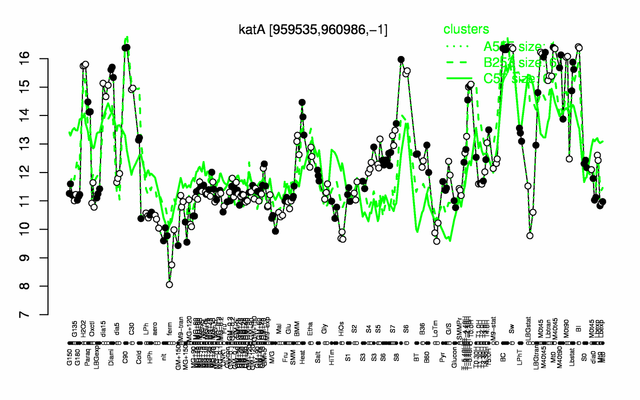Difference between revisions of "KatA"
| Line 128: | Line 128: | ||
** number of protein molecules per cell (minimal medium with glucose and ammonium): 1347 {{PubMed|24696501}} | ** number of protein molecules per cell (minimal medium with glucose and ammonium): 1347 {{PubMed|24696501}} | ||
** number of protein molecules per cell (complex medium with amino acids, without glucose): 452 {{PubMed|24696501}} | ** number of protein molecules per cell (complex medium with amino acids, without glucose): 452 {{PubMed|24696501}} | ||
| + | ** number of protein molecules per cell (minimal medium with glucose and ammonium, exponential phase): 3140 {{PubMed|21395229}} | ||
| + | ** number of protein molecules per cell (minimal medium with glucose and ammonium, early stationary phase after glucose exhaustion): 4640 {{PubMed|21395229}} | ||
| + | ** number of protein molecules per cell (minimal medium with glucose and ammonium, late stationary phase after glucose exhaustion): 7391 {{PubMed|21395229}} | ||
=Biological materials = | =Biological materials = | ||
| − | |||
* '''Mutant:''' | * '''Mutant:''' | ||
Revision as of 14:09, 17 April 2014
- Description: main vegetative catalase 1
| Gene name | katA |
| Synonyms | kat-19 |
| Essential | no |
| Product | vegetative catalase |
| Function | detoxification (degradation) of hydrogen peroxide |
| Gene expression levels in SubtiExpress: katA | |
| Metabolic function and regulation of this protein in SubtiPathways: katA | |
| MW, pI | 54 kDa, 6.151 |
| Gene length, protein length | 1449 bp, 483 aa |
| Immediate neighbours | senS, ssuB |
| Sequences | Protein DNA DNA_with_flanks |
Genetic context 
This image was kindly provided by SubtiList
| |
Expression at a glance PubMed
| |
Contents
Categories containing this gene/protein
resistance against oxidative and electrophile stress, phosphoproteins
This gene is a member of the following regulons
The gene
Basic information
- Locus tag: BSU08820
Phenotypes of a mutant
- increased sensitivity to oxidative stress PubMed
Database entries
- BsubCyc: BSU08820
- DBTBS entry: [1]
- SubtiList entry: [2]
Additional information
The protein
Basic information/ Evolution
- Catalyzed reaction/ biological activity: 2 H2O2 = O2 + 2 H2O (according to Swiss-Prot)
- Protein family: catalase family (according to Swiss-Prot)
- Paralogous protein(s):
Extended information on the protein
- Kinetic information:
- Domains:
- Modification:
- phosphorylated on Arg-366 PubMed
- Cofactor(s): contains an iron-sulfur cluster, heme
- Effectors of protein activity:
- Localization:
- cytoplasm (according to Swiss-Prot)
Database entries
- BsubCyc: BSU08820
- Structure: 1SI8 (enzyme from Enterococcus faecalis, 68% identity)
- UniProt: P26901
- KEGG entry: [3]
- E.C. number:
Additional information
Expression and regulation
- Operon: katA PubMed
- Sigma factor:
- Additional information:
- number of protein molecules per cell (minimal medium with glucose and ammonium): 1347 PubMed
- number of protein molecules per cell (complex medium with amino acids, without glucose): 452 PubMed
- number of protein molecules per cell (minimal medium with glucose and ammonium, exponential phase): 3140 PubMed
- number of protein molecules per cell (minimal medium with glucose and ammonium, early stationary phase after glucose exhaustion): 4640 PubMed
- number of protein molecules per cell (minimal medium with glucose and ammonium, late stationary phase after glucose exhaustion): 7391 PubMed
Biological materials
- Mutant:
- Expression vector:
- lacZ fusion:
- GFP fusion:
- two-hybrid system:
- Antibody:
Labs working on this gene/protein
Your additional remarks
References